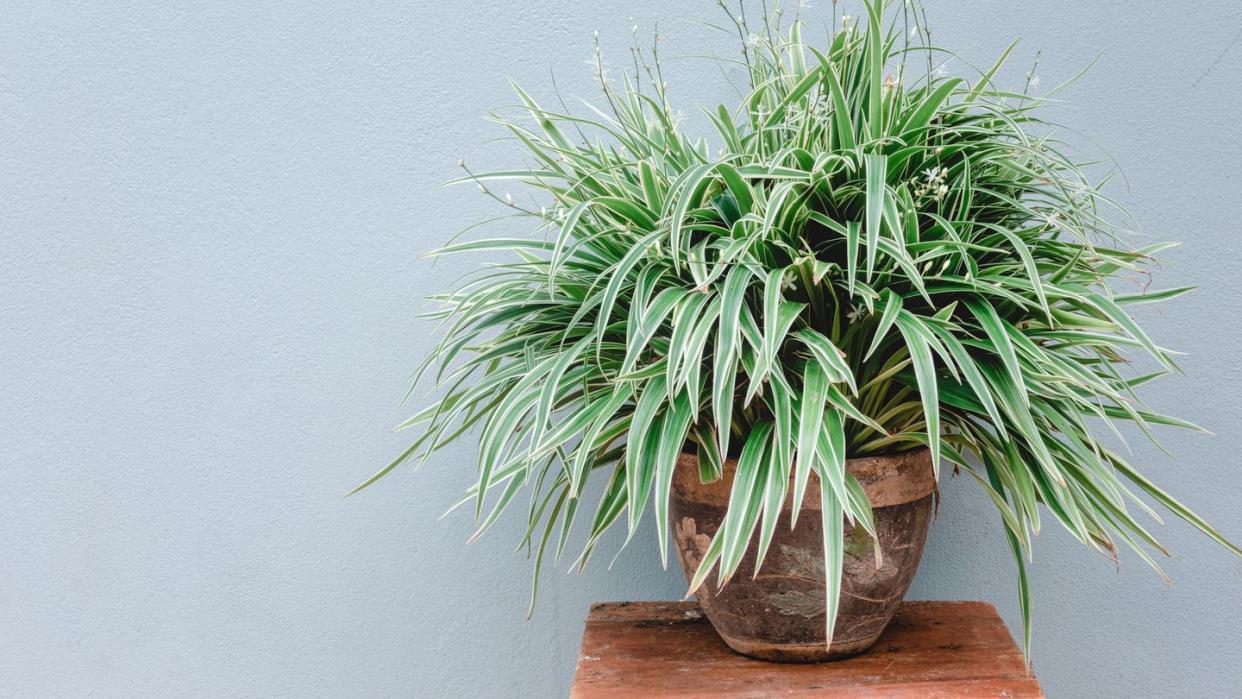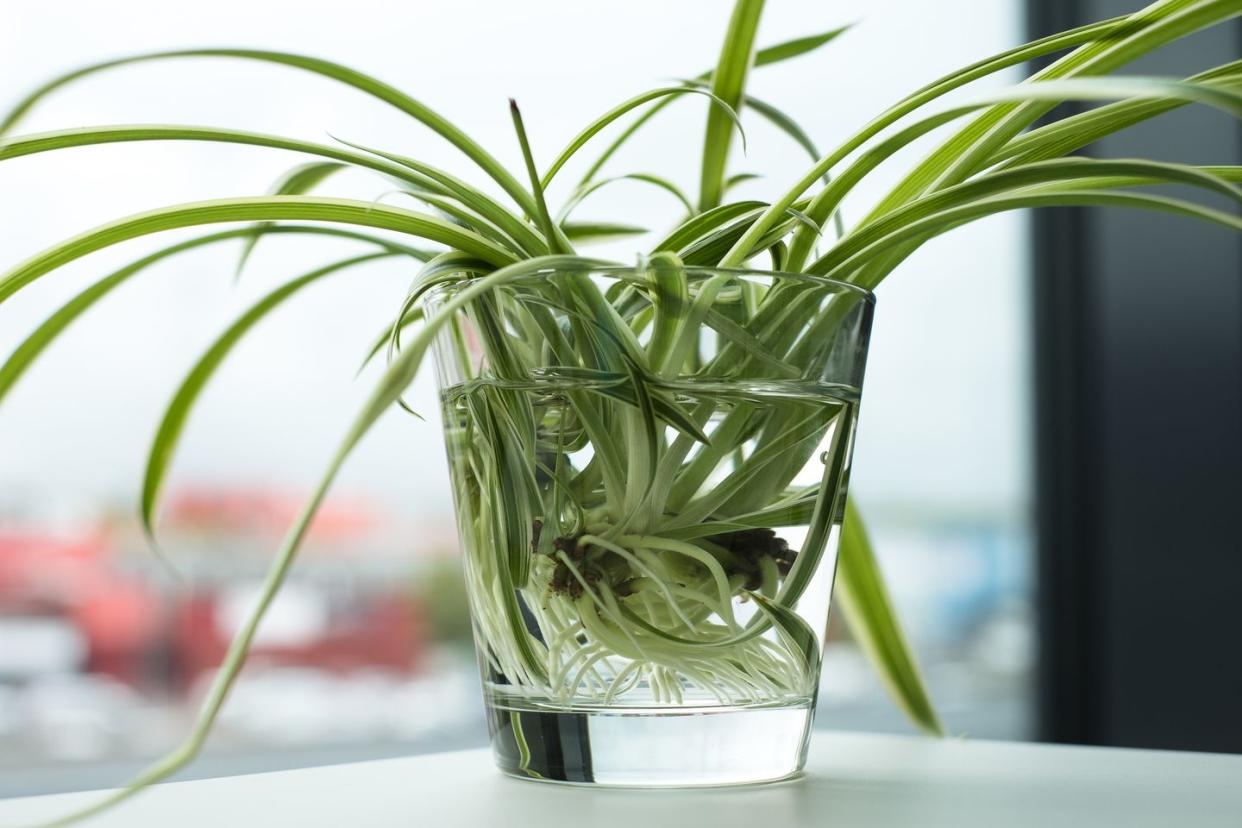How to Grow Spider Plants That Sprout Lots of "Babies"

"Hearst Magazines and Yahoo may earn commission or revenue on some items through these links."
If you're looking for an easy and fun houseplant to add to your collection, consider getting a spider plant. Beloved for its voluminous shape, low-maintenance care routine, and easy propagation, the spider plant is ideal for beginner and experienced green thumbs alike. As a bonus, spider plants are nontoxic to dogs, cats, and humans, so you don't have to worry about placing them out of reach.
The plant is named for its curling, leggy fronds that mimic the look of angled spider legs. Visually, the plant boasts stunning stripes, variegated in shades of green. The brighter the verdant hues, the healthier the plant. These trailing plants can also help purify the air wherever you place or hang them.
“Chlorophytum, commonly known as the spider plant, come in several interesting varieties and are also super easy to propagate which makes for fun gift giving,” says Allison Futeral, plant care expert and owner of Crimson Horticultural Rarities. “Chlorophytum can brighten up any room and are well suited for any and all levels of plant lovers.”
Spider plants are a great starting place for any at-home gardener since they adapt well to a variety of indoor environments and won't immediately wilt if you miss a few days of watering. Read on for our expert-approved care guide for spider plants, covering everything from how much watering, soil, light, and attention they need.
Spider Plant Care
Water
Like most houseplants, spider plants prefer to be moist, but never soggy. Futeral recommends not watering until your soil is completely dried out. To check this, stick your finger an inch or so into your plant pot to feel for moisture.
Potting your spider plant in a planter with a drainage hole or drainage rocks can help excess water flow out and prevent root rot. Crispy leaves are a sign of underwatering, while dark brown leaf tips are a clear sign of overwatering. You want your spider plant to be vibrant and perky.
Sunlight
Beloved for being incredibly low-maintenance, the spider plant can be placed anywhere with low to indirect bright light. Fun fact: The brighter the sunlight, the more distinct stripes your plant will produce.
“While they do best in a medium light, they can also tolerate lower light conditions. Just keep in mind that the plant may grow a bit slower,” says Futeral. Too much sun, though, and the leaves will scorch. A grow light can help the plant thrive in low-light conditions.
Soil
To avoid flooding the roots, plant spider plants in well-draining soil. Fertilizer isn't necessary, but it can help jump-start new growth in spring and summer. Futeral recommends fertilizing spider plants once a month during warmer weather.
Humidity and Temperature
Normal household humidity is perfectly fine for your spider plant, but to go the extra mile, mist your plant regularly (once or twice a week) with a spray bottle of water. Again, dry, crispy tips are a sign your plant is dehydrated and needs more humidity. Temperature-wise, anywhere from 60 to 80 degrees Fahrenheit is the ideal range for a spider plant.
How to Propagate a Spider Plant

One of the reasons people love spider plants is because they frequently produce “babies,” or miniature offshoots from the original plant. You will clearly be able to tell when a baby spider plant has formed, as its stalk will be thin and straw-like instead of leafy and green, and the miniature plant will sprout leaves of its own.
To propagate your spider plant, trim off the smaller plant and place the bottom in a glass of water. Once roots have developed, transfer the offshoot into soil, and water it regularly.
How to Prune a Spider Plant
While pruning a spider plant isn't necessary for the plant's health, doing this can be helpful to curb any chaotic growth or trim the plant back when it's taking over your bookcase. You can also trim and remove the smaller plants if you feel your plant needs a good cleanup. Removing them at any stage won't harm your spider plant. Similar to the propagation process, you'll want to snip off the baby growths, but instead of allowing them to grow roots, you can toss them or add them to your compost pile.
How to Pot a Spider Plant
Because of its long, trailing leaves, we recommend a hanging planter to allow the plant to spread out. And, according to the University of Wisconsin-Madison Extension, the plant does best when planted in a slightly smaller pot: “Use a general-purpose potting soil or mix. Plants grow and produce plantlets best when slightly pot-bound. Because they grow quickly and the roots can easily become too crowded, they need frequent repotting to do their best.”
Common Spider Plant Problems
Leaves Are Turning Brown
The most common cause of a spider plant's brown, crispy leaves is dehydration. However, if the leaf ends are dark brown and slightly mushy, it's an issue of too much water, rather than too little. Before you dunk your spider plant in the sink, it's important to remove any fully brown leaves or dried-out portions of the plant. After you've done that, try using filtered or distilled water to water your spider plants. Tap water can be too harsh for some houseplants, according to the University of Florida IFAS Extension. If you don't see a change, try increasing the humidity by misting it between regular waterings.
Color Is Fading
If the spider plant's color is fading and stripes are losing their vitality, your plant most likely needs more water and more sunlight. Remember, the brighter and more distinct the striping, the healthier the plant. Water your spider plant completely and try to add some fertilizer or plant food to the soil to give your plant the boost it needs.
Not Producing Any Offshoots
If your plant has stopped producing miniature spiders, there could be a couple of potential causes: too little water or too much sun. You can tell if too much sun is the reason if the leaves are light brown and crispy. If neither seems to be the cause, your plant might need repotting in a larger pot.
According to the University of Florida IFAS Extension, “A potted spider plant will thrive with repotting once a year while the plant is young and then every other year once it matures.” To check for this, carefully remove your plant from its current pot and see if the roots look tangled or bursting at the seams. You might also be able to see roots poking out the top of the soil.
Follow House Beautiful on Instagram and TikTok.
You Might Also Like
